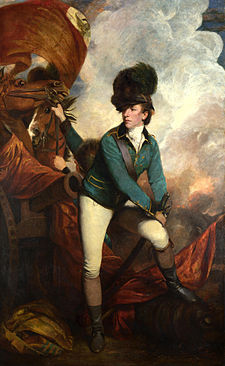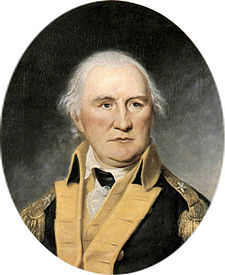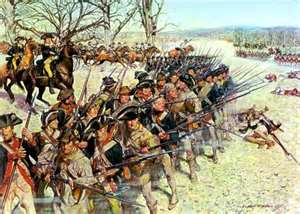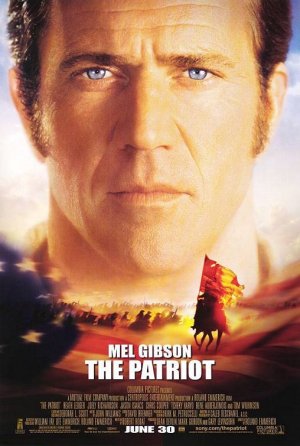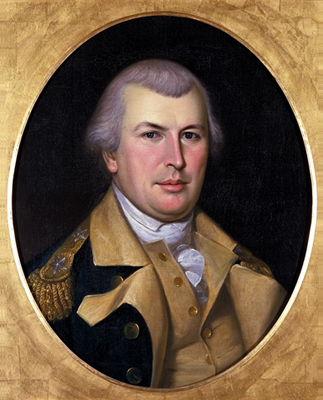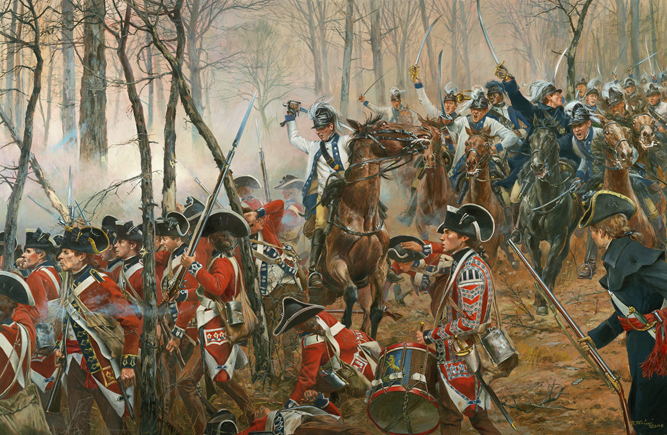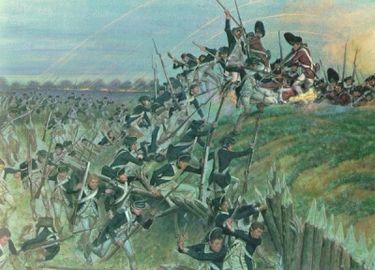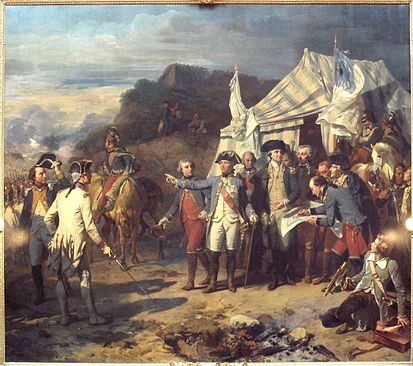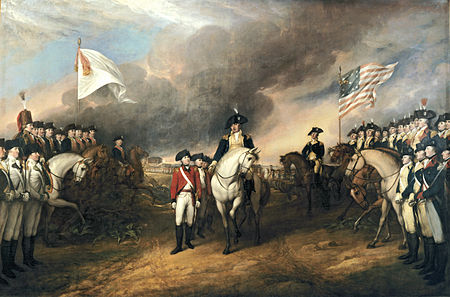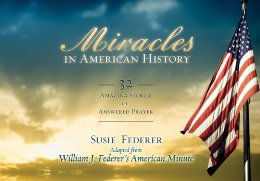|
American Minute
“The Bloody Butcher” defeated at Battle of Cowpens, portrayed in “The Patriot” movie – the strategic turning point of Revolutionary War!
|
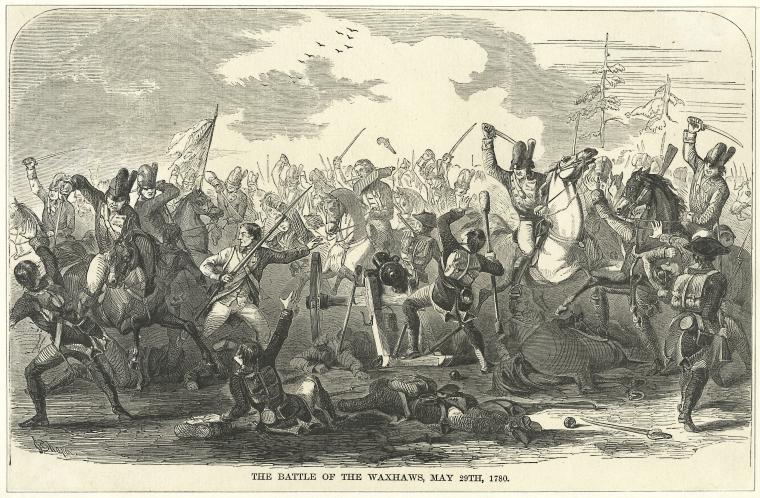 “The bloody butcher” is what colonists called British Colonel Banastre Tarleton. “The bloody butcher” is what colonists called British Colonel Banastre Tarleton.
He let his dragoons bayonet and hack hundreds of surrendering Americans at Buford’s Massacre during the Battle of Waxhaw, May 29, 1780.
In January of 1781, 26-year-old Colonel Banastre Tarleton led 1,200 of Britain’s best troops, consisting of British dragoons, regulars, highlanders and loyalists, in a day-long, non-stop pursuit of the Americans.
American General Daniel Morgan led Colonel Banastre Tarleton into a trap — the Battle of Cowpens, JANUARY 17, 1781.
The Americans took a stand at two low hills with the Broad River behind them, leaving them no opportunity to retreat.
Seeing this as a tactically foolish move, British Colonel Tarlton gave into the temptation to pursue the Americans without doing any reconnaissance. This scene was depicted in the movie, The Patriot, in which Mel Gibson’s character Benjamin Martin, is a composite portrayal of the fiercest Carolina fighters: -Gen. Andrew Pickens (nicknamed “the Wizard Owl”); Approaching Cowpens, without allowing his fatigued troops to catch their breath after their exhaustive day long march, Tarlton ordered a headlong attack upon the American militia. American General Daniel Morgan had his line of militia fire twice into the charging British cavalry, then quickly retreat around a hill. Tarlton’s dragoons were now at a full gallop, charging toward the American position. Suddenly, Tarlton discovered that behind the militia was hiding a wall of 400 battle-hardened American Continental soldiers, with their rifles leveled.
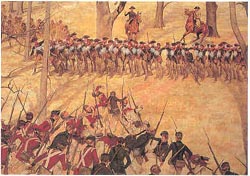
The American Continentals stood immovable and fired at point-blank range. Over 100 dragoons were hit and dropped them from their saddles.
Then the militia which had retreated circled around and appeared on the other side of the hill to attack Tarlton’s flank. Tarlton barely escaped.
In the confusion, 110 British were killed and 830 captured.
Captured British officer, Maj. McArthur of the 71st Highlanders commented that “he was an officer before Tarleton was born; that the best troops in the service were put under ‘that boy’ to be sacrificed.”
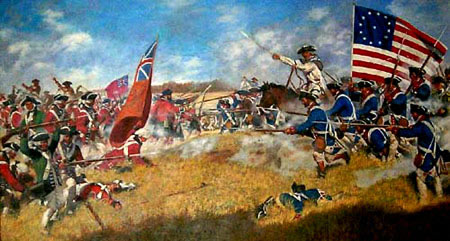
The Battle of Cowpens is widely considered the tactical masterpiece and turning point of the Revolutionary War. Get the DVD Vol. 1- Miracles in American History (Episodes 1-10) When British General Cornwallis was told the news, he was leaning on his sword — and leaned so hard the blade snapped. Cornwallis gave chase, abandoning his slow supply wagons so he could pursue faster.
General Daniel Morgan hastily retreated north, meeting up with American General Nathanael Greene.  They raced to get out of South Carolina, across North Carolina to the border of Virginia, where was the Great Dismal Swamp–over 100,000 acres of dangerous wetlands which would prevent British pursuit.
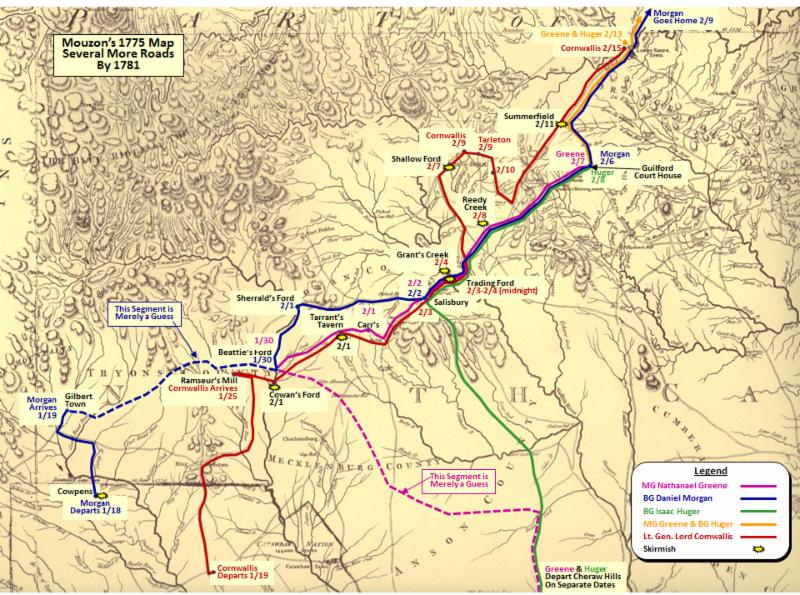
Cornwallis regrouped to chase the Americans as fast as he could, discarding his slow and cumbersome supply wagons. Cornwallis arrived at the Catawba River just two hours after the Americans had crossed, but a sudden storm made the river impassable, delaying the British pursuit. The British nearly overtook the Americans at the Yadkin River, but again rains flooded the river slowing the British. Now it was a frantic race to the Dan River. 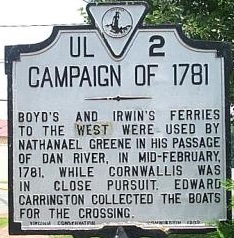 The local historical marker reads:
“Boyd’s and Irwin’s ferries to the west were used by Nathanael Greene in his passage of Dan River, in mid-February, 1781, while Cornwallis was in close pursuit.”
General Nathanael Greene quickly got the Americans across the Dan River, then another storm and flash flood ended the British chase.
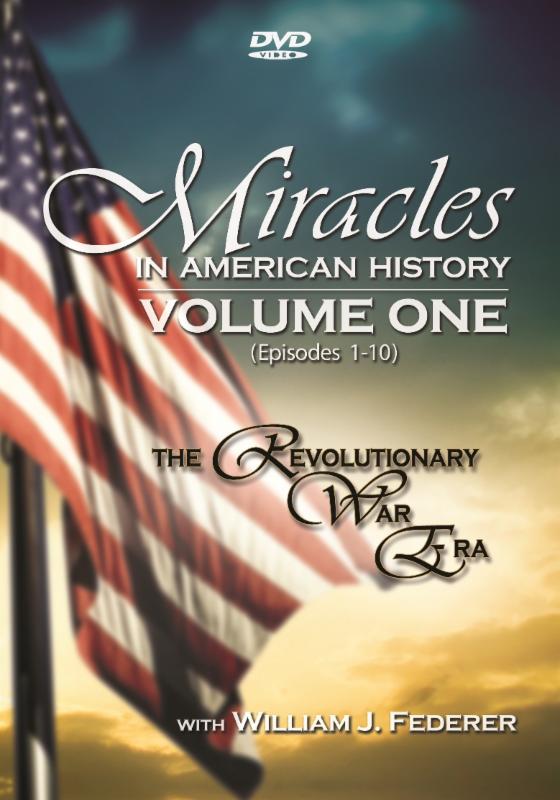 British Commander Henry Clinton wrote:
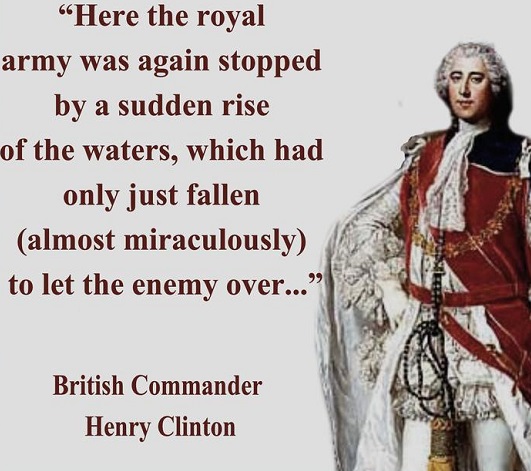
“Here the royal army was again stopped by a sudden rise of the waters, which had only just fallen (almost miraculously) to let the enemy over, who could not else have eluded Lord Cornwallis’ grasp, so close was he upon their rear.”
Having discarded his supply wagons in the desperate chase, Cornwallis was now at a logistical disadvantage. General Nathanael Greene recrossed and fought against Cornwallis again at the Battle of Guilford Court House, March 15, 1781. Colonel Tarleton was shot in the right hand, causing the loss of two fingers. Though the British technically won that battle, their heavy losses of over 500 killed or wounded, and their failure to capture American supplies, contributed to their subsequent defeat. Badly needing supplies for his army, Cornwallis was ordered by British General Henry Clinton to move his 8,000 troops to a defensive position where the York River entered Chesapeake Bay, and wait for British ships to come to his aid.
Providentially, Ben Franklin and Marquis de Lafayette were successful in their efforts to persuade French King Louis XVI to send ships and troops to help the Americans. French Admiral de Grasse left off fighting the British in the West Indies and sailed 24 ships to the mouth of Chesapeake Bay, where he arrived just a perfect time to fight in the Battle of the Capes. Admiral de Grasse successfully drove off the 19 British ships which were trying to evacuate Cornwallis’ men.
Then De Grasse’s 3,000 French troops and General Rochambeau’s 6,000 French troops hurriedly joined General Lafayette’s division as they marched to Yorktown. There they joined General Washington in trapping Cornwallis against the sea.
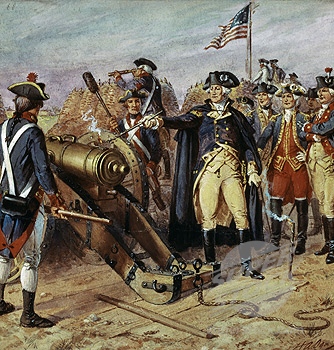
French troops also joined the ranks of: -General Benjamin Lincoln,
-General Baron von Steuben, -General Modecai Gist, -General Henry Knox and -General John Peter Muhlenberg. Altogether, 17,000 French and American troops surrounded Cornwallis.
On October 19, 1781, Cornwallis surrendered and the Revolutionary War was effectively over. Yale President Ezra Stiles wrote, May 8, 1783: “Who but God could have ordained the critical arrival of the Gallic (French) fleet, so as to … assist … in the siege … of Yorktown? … Should we not … ascribe to a Supreme energy … the wise … generalship displayed by General Greene … leaving the … roving Cornwallis to pursue his helter-skelter ill fated march into Virginia … It is God who had raised up for us a … powerful ally … a chosen army and a naval force: who sent us a Rochambeau … to fight side by side with a Washington … in the … battle of Yorktown.” General Washington wrote to William Gordon in March of 1781: “We have … abundant reasons to thank Providence for its many favorable interpositions in our behalf. It has at times been my only dependence, for all other resources seemed to have failed us.” Schedule Bill Federer for informative interviews & captivating PowerPoint presentations: 314-502-8924 wjfederer@gmail.com
American Minute is a registered trademark.
|

